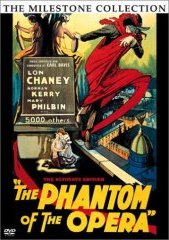
This is the earliest, and still the best, version of the much-filmed story, initially released by Universal Studios in 1925 and extensively revised for a 1929 re-release. Except for a contrived new ending--only one of two that Universal filmed, it is the most faithful to the melodrama by Gaston Leroux upon which it is based.
The story is familiar to most lovers of film. A mad, facially deformed brilliant musician, Erik, known as the "Opera Ghost," lives in the catacombs beneath the Paris Opera House in the late 19th century. With special talents for unseen terrifying machinations, he evokes fear and has all his demands met by the Opera's directors. One day, he falls in love with a young singer named Christine Daae and is persuaded by her budding musical abilities. He uses macabre means to rid the Opera of its reigning prima donna and substitute Christine, her understudy. His hideous face hidden behind a mask, he takes Christine to his underground lair to offer vocal coaching and profess his love. He insists that she stay with him, forsaking normal life and her lover, Raoul de Chagny. Eventually, Christine cannot deal with this deranged, murderous character and pleads to be released. Realizing that love and possessiveness are inconsistent, Erik ultimately obeys her wish. In the novel and in stills of the alternate, lost filmed ending, Erik then dies of a broken heart. For the actual release, Universal substituted a scene of mob violence where the Phantom is murdered and his body thrown into the Seine.
The original 1925 release is not the one most people know. It survives only in poor-quality 16mm "show-at-home" copies and is included as the second disc of the Milestone set. Despite the quality of the print, it is clearly the superior version, all the choices for camera angles, plotting far outdistancing the shorter, better-known 1929 reissue. It is accompanied by a good organ score composed by Jon Mirsalis.
The selling point of the set, however, is a restored print of the 1929 reissue, made from a brilliantly preserved negative in the George Eastman Archive. The restoration was done in Britain by Photoplay, and a fine new orchestral score was composed for it by Carl Davis of the BBC. Having seen the Photoplay restoration, I can say that it is indeed very impressive, restoring the film's original tinting and re-working the two-strip Technicolor in the "Bal Masque" scene. The print looks crisp and glorious.
The Milestone R1 DVD, however, is beset by problems that make it unwatchable. Various factors (Milestone engineers give people double-talk about the reasons) resulted in two dire problems. [1] it runs slower, not normally a problem when dealing with silent films, but the synchronized Davis score also runs slow and is therefore a semitone *low*! Generally PAL-to-NTSC transfers run a semitone *high* so I am at a loss to explain this particular aberration. [2] Even worse, the transfer introduces motion blur: any movement has a multi-ghosting appearance, and even still frames are blurred. No other transfer has this ghastly problem. It is shocking that Milestone thought something so awful was acceptable. There is another minor peculiarity in the 1929 reissue, owing to a decision made by the producers of the original 1996 Photoplay restoration: in 1929, a prologue spoken by a man holding a lantern in the catacombs was introduced. According to speculation by film historian Scott MacQueen, it was intended to have synchronized sound, but the sound does not exist. Photoplay cut the scene. It may have been a logical decision on some level, but no other version makes such a deletion, and it is historically unconscionable--especially if the sound elements for the scene turn up. Moreover, Milestone, didn't even include it as one of the many bonus features. Oddly, a portion of this prologue, in poor quality, found its way into the original 1925 version on the second disc, where it doesn't belong. The pity is that the disc has wonderful features including a second sound track with dialogue from the 1930 reissue, full-length commentary by Scott MacQueen, and every extant bit of publicity and historical material anyone could want.
However, because of the motion blur in the restored 1929 reissue, this set is valuable only for the extras and the poor-quality 1925 original version on the second disc--the only available source of the older release; that second disc even contains stills and running plot continuity from Universal's two preview versions including the gentle ending (though playing this continuity, annoyingly, cannot be paused or scanned). For the 1929 reissue, beware the Milestone and stick with the 1997 R1 Image DVD.
Review by Robert E. Seletsky
| Released by Milestone Edition |
| Region 1 - NTSC |
| Not Rated |
| Extras : |
| see main review |